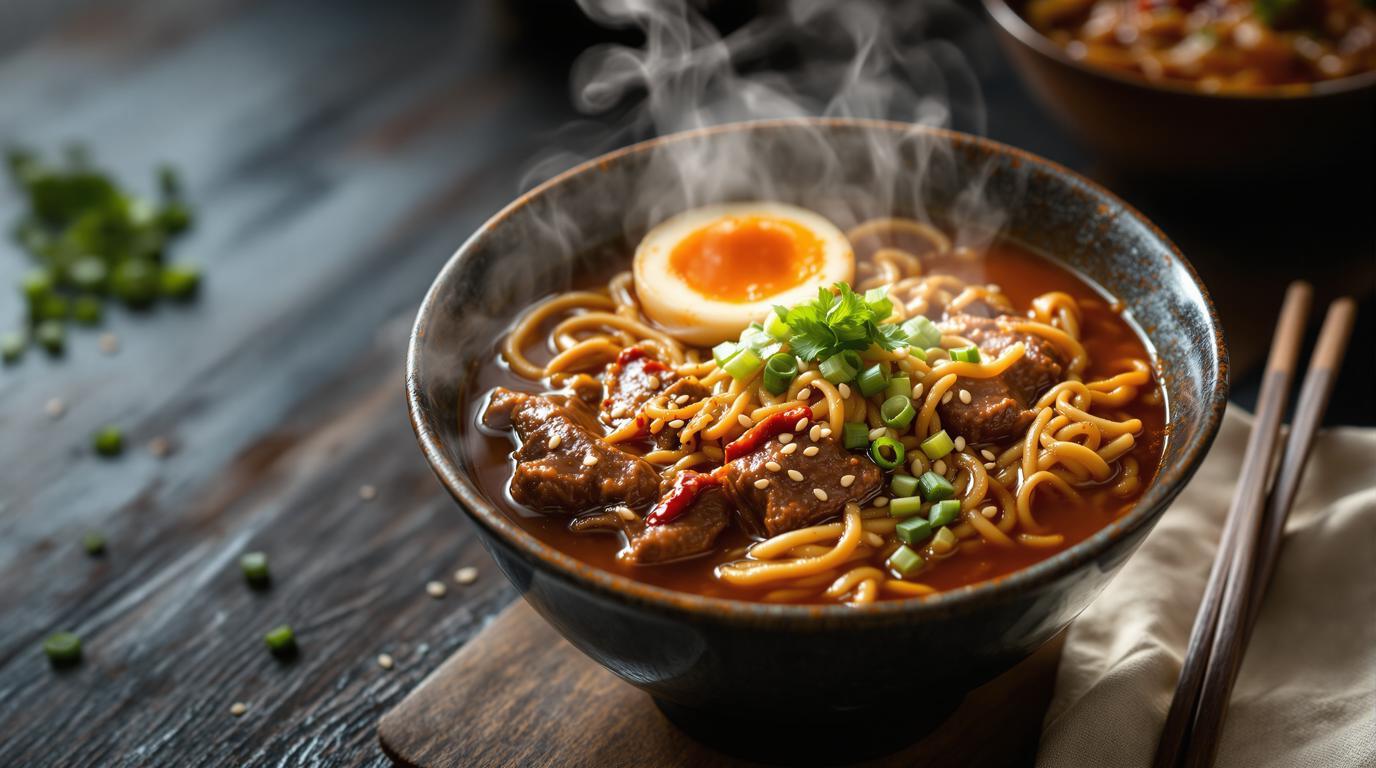The first time I encountered authentic ramen beyond the instant packets was during my stint at a small family-owned restaurant in Osaka. The grandmother—who everyone respectfully called Obaachan—would spend hours tending to her spicy beef broth, the fragrant steam fogging up the kitchen windows. The resulting broth was a revelation: intensely savory with layers of heat that didn’t overwhelm but rather enhanced every bite. Today’s recipe captures that same depth and complexity, blending traditional Chinese spice foundations with Japanese ramen techniques for a bowl that tells a story with each slurp.
The Story Behind Spicy Beef Ramen
While most people associate ramen with Japan, its spicier variations often reveal Chinese influences, particularly from Sichuan cuisine. What makes this grandmother-style version special is the patience involved—the slow braising of beef that transforms an inexpensive cut into tender morsels swimming in a broth that’s had hours to develop character. Unlike quick versions that rely on ground beef, this recipe honors the traditional method where time becomes an essential ingredient.
Ingredients Spotlight
The soul of this dish lies in doubanjiang, a fermented Sichuan chili bean paste that delivers complex heat rather than mere spiciness. If you can’t find it, Korean gochujang makes a worthy substitute, though with a slightly different flavor profile.
- 2 lbs (900g) beef chuck or pot roast, cut into 2-inch chunks
- 2-3 Tbsp doubanjiang (Sichuan chili bean paste)
- 4 Tbsp soy sauce
- 2 Tbsp fresh ginger, finely grated
- 4 garlic cloves, minced
- 2 medium yellow onions, thinly sliced
- 2 star anise pods
- 1 cinnamon stick
- 6 cups beef stock
- 2 tsp toasted sesame oil
- 4 portions fresh or dried ramen noodles
- 4 eggs, soft-boiled (6½ minutes)
- 4 scallions, thinly sliced
- 2 Tbsp toasted sesame seeds
Step-by-Step Guide
The magic happens in three distinct phases:
- Prepare the beef: Pat meat dry with paper towels (critical for proper browning). Season generously with salt and pepper. In a Dutch oven over medium-high heat, sear the beef in batches until deeply browned on all sides (about 3 minutes per side). Remove and set aside.
- Create the flavor base: In the same pot, reduce heat to medium and add onions. Cook until they begin to caramelize (about 8 minutes), then add garlic and ginger. Cook for 1 minute until fragrant. Add doubanjiang and stir continuously for 30 seconds—this “blooms” the paste, releasing its full flavor potential.
- Develop the broth: Return beef to the pot. Add soy sauce, star anise, cinnamon stick, and beef stock. Bring to a simmer, then reduce heat to low. Cover and cook for 3-4 hours, until beef is fork-tender. In the final 30 minutes, remove the lid to allow some reduction and concentration of flavors.
- Assemble: Remove beef and shred with two forks. Strain broth if desired for a cleaner presentation (I usually don’t—those bits carry flavor!). Cook ramen noodles according to package directions, then drain and divide among four bowls. Ladle hot broth over noodles, add shredded beef, half an egg, scallions, and a sprinkle of sesame seeds.
Expert Techniques
The difference between good ramen and exceptional ramen often comes down to technique. When searing the beef, resist the urge to move it around—letting it develop a proper crust is essential for depth of flavor. Also, consider reserving about a cup of your noodle cooking water; this starchy liquid can be added to the broth if you need to adjust consistency without diluting flavor.
Chef’s Note: The broth will continue developing flavor overnight in the refrigerator. If you can plan ahead, make the broth component a day in advance, then simply reheat, cook fresh noodles, and assemble when ready to serve. The flavors will be noticeably more harmonious.
For the soft-boiled eggs, timing is everything. Exactly 6½ minutes in boiling water, followed by an immediate ice bath, creates that perfect jammy yolk that’s still soft but not completely runny.
Presentation & Pairing Ideas
Serve this spicy beef ramen in deep, wide bowls that showcase the various components. I like to arrange the beef and egg on one side, with scallions and sesame seeds scattered across the surface of the broth. For beverages, Japanese beer works wonderfully, cutting through the richness, but don’t overlook the unexpected delight of a slightly chilled Gewürztraminer, whose aromatic profile complements the spices beautifully.
For those looking to accommodate dietary restrictions, this recipe adapts well to gluten-free noodles made from rice or sweet potato starch. In warmer seasons, consider adding quick-pickled cucumbers or radishes as a bright, cooling contrast to the spicy broth.
The true beauty of grandmother-style cooking isn’t rigid adherence to rules but rather understanding fundamental techniques and making them your own. Don’t be afraid to adjust the spice level or experiment with different toppings like blanched bok choy or sautéed mushrooms. After all, the most memorable bowls of ramen are the ones that tell your unique culinary story. For dessert, consider something light and elegant to balance the rich meal, or explore these authentic churros for a sweet finish.
